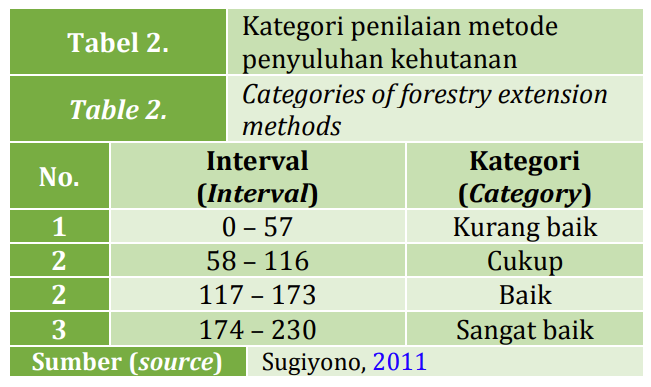Implementation of forest extension methods in improving the knowledge and skills of forest farmers in Maros District
Case study on forestry extension methods in Tompobulu District, Maros Regency

Downloads
Downloads
Ban, A. W. van den, Hawkins, H. S., & Herdiasti, A. D. (1999). Penyuluhan Pertanian. Kanisius.
Fauzi, H. (2017). Pengetahuan Penyuluh Kehutanan Sebagai Pelaku Pemberdayaan Masyarakat dalam Pengelolaan Hutan. Jurnal Hutan Tropis, 5(1), 14–21.
Harinta, Y. W. (2011). Adopsi Inovasi Pertanian di Kalangan Petani di Kecamatan Gatak Kabupaten Sukoharjo. Agrin, 15(2), 164–174.
Kandzior, A., & Rivas, E. (2014). Application of a Participatory Approach to Forestry Extension Activities BT - Tropical Forestry Handbook (L. Pancel & M. Ko hl (Eds.); pp. 1–12). Springer Berlin Heidelberg.
Lawrence, A., Deu, P., Hujala, T., Nichiforel, L., Feliciano, D., Jodlowski, K., Lind, T., Marchal, D., Talkkari, A., Teder, M., Vilkriste, L., & Wilhelmsson, E. (2020). Extension , advice and knowledge systems for private forestry : Understanding diversity and change across Europe. Land Use Policy, 94(December 2019).
Mahbub, M. (2007). Penyuluhan Kehutanan Partisipatif. Jurnal Hutan dan Masyarakat, 2(3), 313-318.
Mardikanto, T. (2009). Sistem Penyuluhan Pertanian. Surakarta. Universitas Sebelah Maret Press.
Mujiburrahmad, M., Muljono, P., & Sadono, D. (2015). Kinerja Penyuluh Pertanian di Kabupaten Pidie Provinsi Aceh dalam Melaksanakan Tugas dan Fungsi. Jurnal Penyuluhan, 10(2), 141–150.
Sapar, Jahi, A., Asngari, P. S., Amiruddin, & Purnaba, I. G. P. (2012). Kinerja Penyuluh Pertanian dan Dampaknya pada Kompetensi Petani Kakao di Empat Wilayah Sulawesi Selatan. Jurnal Penyuluhan, 8(1), 54-57.
Sugiyono. (2011). Metode Penelitian Bisnis. CV. Alfabeta.
Suharsimi, A. (2010). Prosedur Penelitian Suatu Praktik. In Revisi VI. Rineka Cipta.
Sumardjo, & Mulyandari, R. S. H. (2011). Pengembangan sistem informasi berbasis teknologi Informasi untuk pemberdayaan petani sayuran. Prosiding Hasil-Hasil Penelitian IPB 2011, p472.
Suyadi, Sumardjo, Uchrowi, Z., & Tjitropranoto, P. (2019). Pengaruh Penyuluhan Kehutanan Terhadap Peran Kepemimpinan Informal di Lingkungan Taman Nasional Gunung Ciremai Provinsi Jawa Barat. Jurnal Penelitian Sosial dan Ekonomi Kehutanan. 16(1), 25–41.
Zega Hutan. (2020). Metode Penyuluhan Kehutanan Terbaru. Materi. https://www.zegahutan.com/2020/03/metode-penyuluhan-kehutanan-terbaru.html.








